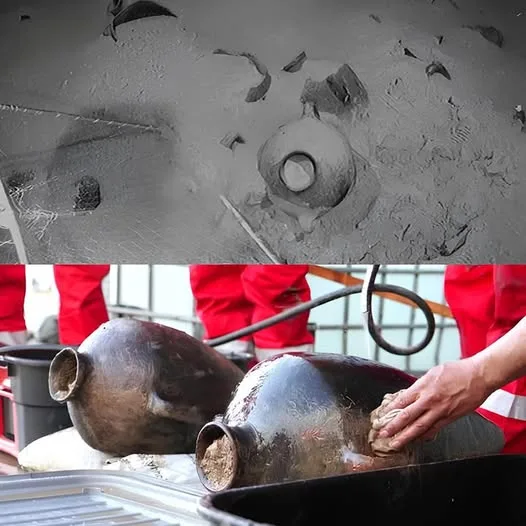Ancient Canaanite Merchant Vessel: A Deep-Sea Revelation
An ancient Canaanite merchant vessel, estimated to be between 3,400 and 3,300 years old, has emerged as a groundbreaking discovery on the Mediterranean seafloor, located nearly 2 kilometers underwater and approximately 90 kilometers off Israel’s coast. Unearthed during a survey by the energy company Energean-E&P, this shipwreck, identified in 2024, challenges long-held assumptions about ancient maritime practices. The Israel Antiquities Authority (IAA) reported that Energean employed sonar technology and a specialized robotic system to locate and retrieve samples, revealing hundreds of intact pottery jars and suggesting a sudden sinking. As of July 2025, this find redefines our understanding of early seafaring, highlighting advanced navigational skills and the confidence of Mediterranean sailors in exploring open waters far from shore.

Discovery and Context
The wreck was detected during an environmental survey for Energean’s Orca natural gas field, a routine operation that unexpectedly turned archaeological. Using sonar, the team identified an anomaly 1.8 kilometers deep, prompting the deployment of a remotely operated vehicle (ROV) to investigate. The ROV’s footage revealed a heap of Canaanite amphorae—storage jars dating to 1400–1300 BCE—peeking through the sediment, hinting at a vessel lost during the Late Bronze Age. The site, 90 kilometers from land, marks the first deep-sea shipwreck from this period, contrasting with the shallow coastal wrecks previously known, like those off Turkey.
The Canaanites, thriving along the eastern Mediterranean from modern-day Turkey to Egypt, were key players in Bronze Age trade, exchanging goods like oil, wine, and grain. This vessel’s location suggests it was part of a sophisticated maritime network, challenging the narrative that ancient sailors clung to coastlines for navigation.
Significance and Challenges to Assumptions
This discovery upends the conventional view that Late Bronze Age mariners relied solely on coastal hugging, using landmarks for orientation. The ship’s position, beyond sight of land, implies the use of celestial navigation—tracking the sun, stars, and possibly early instruments—indicating a level of expertise previously underestimated. The intact arrangement of hundreds of jars, some still in apparent chambers, suggests a rapid sinking, possibly from a storm, leak, or pirate attack, with no evidence of crew efforts to jettison cargo.
While the establishment narrative credits this to advanced skill, skepticism arises: could the vessel have been off course, caught in a drift, or aided by luck rather than deliberate navigation? The lack of visible ship remains—buried under mud—leaves room for debate about its size (estimated 39–46 feet) and construction, with only the cargo providing clues. This ambiguity invites reevaluation of how widespread such open-sea voyages were.
Artifacts and Investigation
The ROV retrieved two amphorae on May 30, 2024, after a three-hour ascent, their brown ooze-covered surfaces revealing designs typical of Canaanite pottery. Petrographic analysis is underway to trace their origin, potentially linking them to ports in modern Israel, Lebanon, or Syria, while residue tests may identify their contents. The jars’ pointed bases, designed to sway with the ship’s motion, align with Bronze Age maritime technology, reinforcing their dating.
The wreck’s depth, preserving it from waves and human interference, offers a “time capsule” of trade goods, unlike shallower sites disturbed over millennia. However, the absence of personal effects or ship timbers limits immediate insights into the crew’s identity or the vessel’s fate.
Preservation and Exploration
Managed by the IAA, the site remains largely undisturbed, with plans to exhibit the retrieved jars at Jerusalem’s National Campus for the Archaeology of Israel this summer. Conservation efforts focus on protecting the fragile cargo, using Energean’s technology due to the IAA’s lack of deep-sea capabilities. The muddy seafloor may hold more artifacts, with future missions planned to map and excavate further, balancing archaeological gain with minimal disturbance.
Posts found on X reflect excitement, calling it a “history-changing find” and marveling at ancient navigation, though some caution against overinterpreting without more evidence. Challenges include the site’s depth, requiring costly robotic operations, and potential legal disputes over territorial waters.
Future Prospects
Future explorations could uncover the ship’s hull or additional cargo, clarifying its origin and sinking cause. Advanced imaging and DNA analysis of residues might reveal trade networks’ extent, while studying navigation methods could reshape views on Bronze Age technology. The discovery’s implications for understanding the Late Bronze Age’s interconnected civilizations, including its eventual collapse around 1200 BCE, remain a focal point for research.
Conclusion
The Canaanite merchant vessel, discovered 90 kilometers off Israel at 1.8 kilometers deep, rewrites the story of ancient seafaring with its 3,400–3,300-year-old cargo of intact pottery jars. Unearthed by Energean-E&P’s sonar and robotic system, this find challenges the notion that early sailors avoided open waters, suggesting advanced navigation skills. As the IAA delves deeper, this shipwreck, preserved by the sea’s depths, offers a window into a sophisticated maritime past, inviting us to reconsider the boldness of those who sailed it as of July 2025.





